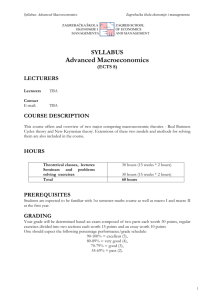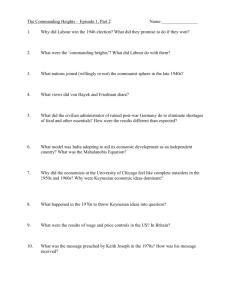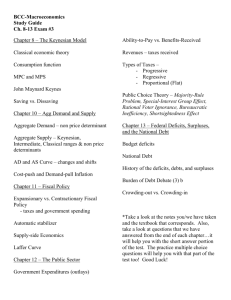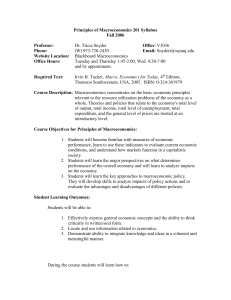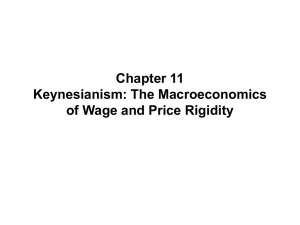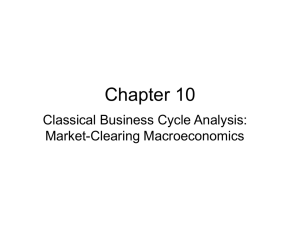Chapters 12-13
advertisement
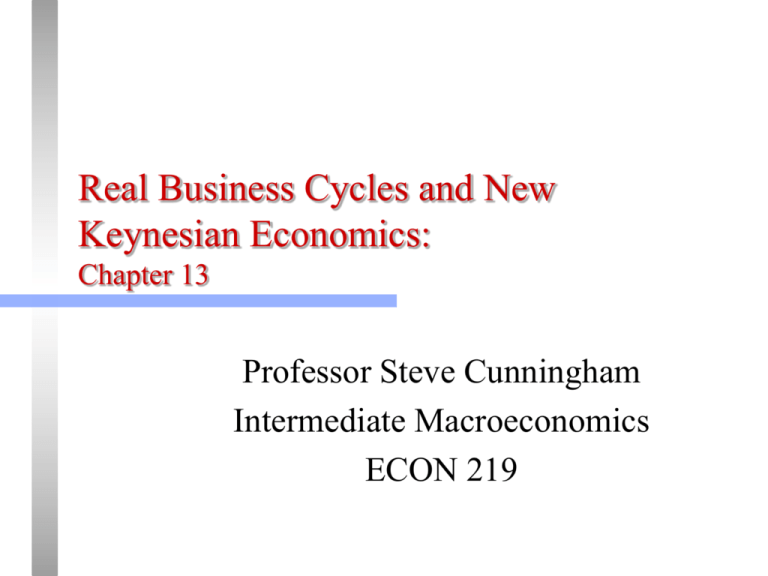
Real Business Cycles and New Keynesian Economics: Chapter 13 Professor Steve Cunningham Intermediate Macroeconomics ECON 219 Real Business Cycle (RBC) Models Like New Classical Economics, the RBC theorists agree that: – – Agents optimize Markets clear Therefore, the business cycle is an equilibrium phenomenon, and is optimal! 2 RBC Theory New Classicals tend to favor monetary business cycles, caused by unexpected fluctuations in the money supply. In contrast, RBC theorists believe that exogenous “real shocks” are largely responsible for business cycles. Such real shocks include: – – – – – Technology changes Environmental conditions Changes in real (relative) prices of basic crude materials and energy sources (oil) Tax rates Individual preferences 3 Typical RBC Model Identical agents. So examine on “representative agent” and multiply by the number of agents in the economy. – This amounts to focusing on the microeconomics and adding up the components to form the macroeconomy. All agents maximize utility by maximizing consumption and leisure (minimize work). Ut U (ct , le ) Output is given by a production function. Yt zt F (K t , Nt ) The term zt captures shocks to production. 4 Model, continued The agent either consumes or saves whatever he or she produces, so: Yt = Ct + St And whatever the agent saves is invested in capital: Kt+1 = St +(1 - )Kt 5 Positive Technology Shock P LRAS1 LRAS2 P1 P2 Y N Y=F(N,K) If a shock occurs that the agent thinks will be temporary, the agent will save more of the increased output for the future, resulting in an increase in capital, affecting future growth. If a shock occurs that the agent thinks will be long-lived, the agent will likely consume a larger proportion of the current period’s increased output. In either case, the effect is more than a single period. 6 RBC Policy Recommendations Monetary Policy – Monetary Policy has little effect on the real sector outcomes, but can affect inflation. Therefore, maintain slow growth of money supply to maintain price stability (no inflation). Fiscal Policy – – Fiscal policy does affect the real economy. Focus should be on removing distortions caused by taxes and inflation. 7 Arguments against RBC The explanation of business cycles does not work. (Problem of persistence) Technology shocks are typically limited to individual industries, and do not have such economy-wide effects. The assumed (voluntary) response by the labor force to changes in the real wage. The real-world labor supply curve is very steep. (Work is a necessity.) 8 New Keynesian Economics Attempts to build Keynesian arguments based upon rational expectations and microeconomic foundations. Examples: – – – Contracting models Sticky price models based upon transactions cost or menu costs Efficiency wage models 9 New Keynesian Models (1) Sticky Prices – Menu costs and other transactions costs: • – It costs to change prices. A firm might hold prices constant even if demand fell if the firm faced a cost to the price change. • • • Costs: loss of customer good will Potential price war Menu costs 10 New Keynesian Models (2) Efficiency Wage Models – – – Firms wish to buy worker effort, not their “attendance”. Instead of Y = F(K,N), the firm really operates according to Y = F(K,eN), where N is the number of workers or worker-hours, and e is the effort per worker. The firm does not seek to minimize the cost of labor, but rather seeks to minimize the cost per efficiency unit. 11 New Keynesian Models (3) Efficiency Wages, continued – By paying the worker more than the equilibrium wage for labor, the firm may reduce the cost per efficiency unit by reducing the costs associated with: • • • – Paying supervisors (monitoring costs) Hiring replacement workers when the current workers leave (turnover costs) Poor worker morale. This leads to: • • • Shirking models, Turnover cost models, and Gift exchange models. 12 New Keynesian Models (4) Efficiency wage models identify a market failure: $ eNs Ns Ns > Nd Nd N, eN 13 New Keynesian Models (5) Insider-Outsider Models and Hysteresis – – – Hysteresis: present unemployment is highly related to past unemployment. Past unemployment causes current unemployment by turning insiders into outsiders. Outsiders cannot exert downward force on real wages. 14
